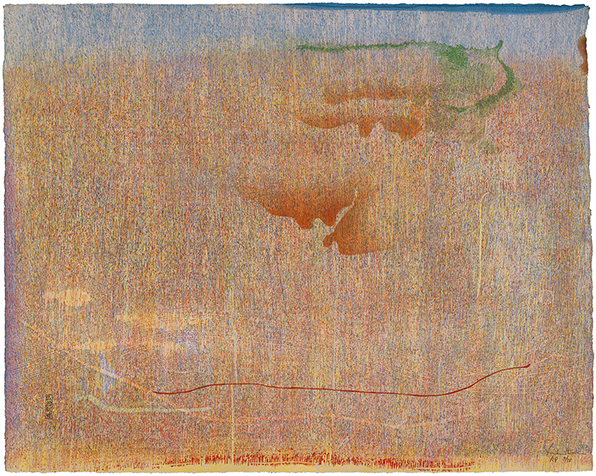
JULY 1–SEPTEMBER 24, 2017
1980s: CAMEO, CEDAR HILL
Helen Frankenthaler
American, 1928–2011
Cedar Hill
1983
Ten-color woodcut from thirteen woodblocks on light pink handmade paper
Helen Frankenthaler Foundation
© 2017 Helen Frankenthaler Foundation, Inc. / Artists Rights Society (ARS), New York / Crown Point Press. Oakland, CA
Although Frankenthaler made only two woodcuts in the 1980s, Cameo (1980) and Cedar Hill (1983) are among the most significant woodcuts of her career. They mark a new approach to color and an increased engagement with the practice of the medium in Japan. Cameo furthered the use of layered color found in Essence Mulberry, resulting in a field of color that influenced the artist’s future works. It also introduced the technique of “guzzying,” a term Frankenthaler used to describe the way she would manipulate the surface of the woodblock, marking it in this case with sandpaper and dental tools to achieve the desired textured effects before printing. The resulting colors are not static and distinct, but rather are subtle and diaphanous.
Cedar Hill was the only print Frankenthaler made in Japan. In the early part of the decade, Kathan Brown, founder of San Francisco’s Crown Point Press, invited her to take part in an international collaborative printmaking project. The concept was for artists to make drawings that would be sent to Japan and turned into woodblock prints using traditional methods. Frankenthaler sent a drawing in 1981, but she was dissatisfied with what she felt was a printmaking process too alienated and distant from her artistic vision. Ever since her first printmaking experiences at ULAE, Frankenthaler had worked closely with print workshops and their dedicated staff in order to ensure the appropriate execution of her complex prints. In 1983 she went to Kyoto to ensure that same level of close collaboration, working alongside the expert woodcarver Reizo Monjyu and the printer Tadashi Toda to produce Cedar Hill.

